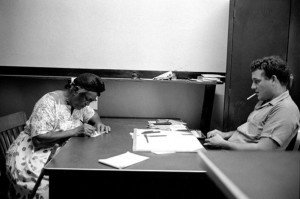Photography and Civil Rights — Yesterday and Today
To commemorate 50 years since the passing of the Civil Rights Act, an exhibit called “The Movement: Bob Adelman and Civil Rights Era Photography” is at the Museum of Art in Fort Lauderdale, Florida.
 The extent of Bob’s show is formidable, showing African American living conditions in the South in the 1960’s, voter registration efforts (left), freedom marches, sit-ins, and Martin Luther King‘s speech at the Washington Monument. Charlton Heston was in the audience!
The extent of Bob’s show is formidable, showing African American living conditions in the South in the 1960’s, voter registration efforts (left), freedom marches, sit-ins, and Martin Luther King‘s speech at the Washington Monument. Charlton Heston was in the audience!
I was reminded of a discussion between Julian Bond and Danny Lyon at the National Geographic seminar this year where Danny talked about his civil rights photography. Julian reiterated that Martin Luther King and other leaders of groups such as the Congress for Racial Equality (CORE), the Student Non-Violent Coordinating Committee (SNCC), and the National Association for the Advancement of Colored People (NAACP) actively recruited photographers to document the civil rights conditions in the United States. Julian told us that King said “We have enough lawyers, we need photographers.”
Many young photographers took up the challenge, including Charles Moore, Dan Budnik, James Karales, Leonard Freed, and Danny and Bob. With several others, they created a legacy of the times. Many of these pictures are iconic — demonstrators blasted by water hoses in Birmingham, school desegregation in Montgomery, sit-ins in Greensboro, and aides pointing to where James Earl Ray fired the shot that killed Martin Luther King at the Lorraine Motel.
After I saw Bob Adelman’s exhibit, it dawned on me that we are witnessing a similar situation happening in the US today. Several Supreme Court decisions in the past two years have changed the landscape. One nullified the the 1965 law that required lawmakers in states with a history of discriminating against minority voters to get federal permission before changing voting rules. Section 5 of the Voting Rights Act had required federal review of new voting rules in 15 states, most of them in the South. Between 1982 and 2006, the Justice Department blocked more than 700 voting changes on the basis that the changes were discriminatory.
Mother Jones Magazine looked at how many of these 15 states passed or implemented voting restrictions after Section 5 was invalidated by the Supreme Court compared to the states that were not covered by the law. They found that 8 of the 15 states, or 53 percent, passed or implemented voting restrictions since June 25, 2013 compared to 3 of 35 states that were not covered under Section 5—or less than 9 percent.
The other Supreme Court decision upheld portions of the Arizona immigration law S.B. 1070 (specifically Section 2(B)) on whether the law unconstitutionally invaded the federal government’s exclusive prerogative to set immigration policy. The justices found that it was not clear whether Arizona was supplanting or supporting federal policy by requiring state law enforcement to demand immigration papers from anyone stopped, detained or arrested in the state whom officers reasonably suspect is in the country without authorization.
Many people (including some justices on the Supreme Court) believe that the civil rights battles of the 1960’s secured these rights for posterity. Civil rights organizations think otherwise and point out numerous recent state house reversals of our “inalienable rights”.
The photographs I see appearing in the media that relate to these recent decisions are mostly one-offs of demonstrations or politicians that are supposedly speaking about the issues. I say “supposedly” as it is impossible in a still photo to know what they are addressing – (Arizona S.B. 1070? Voting rights legislation in North Carolina?)
Where are the in-depth photo essays that give viewers visceral reactions to these subjects? I have searched the web for such photographic stories and have found none. If you, dear reader, know of any, please leave a comment and I will include them in this post.